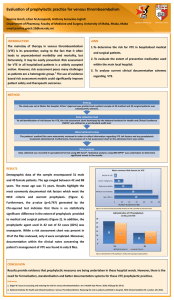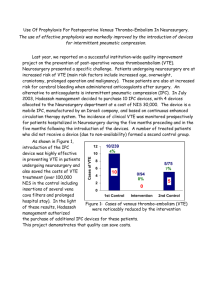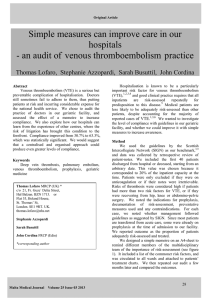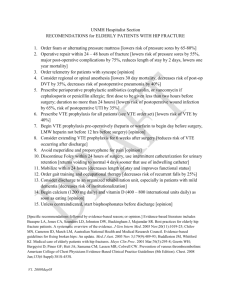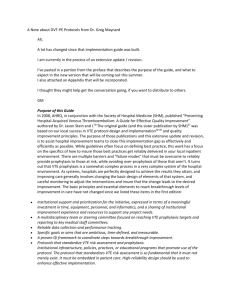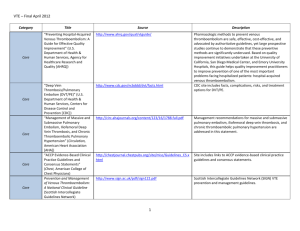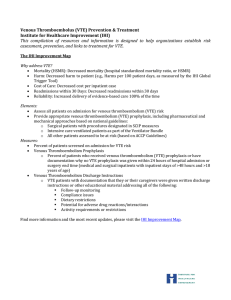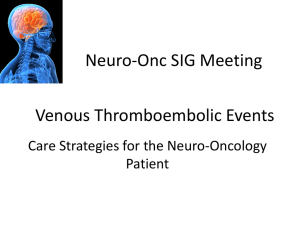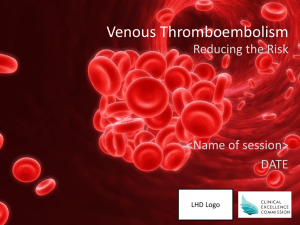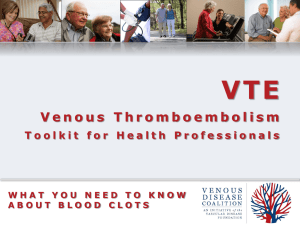WORD - Australian Commission on Safety and Quality in Health Care
advertisement
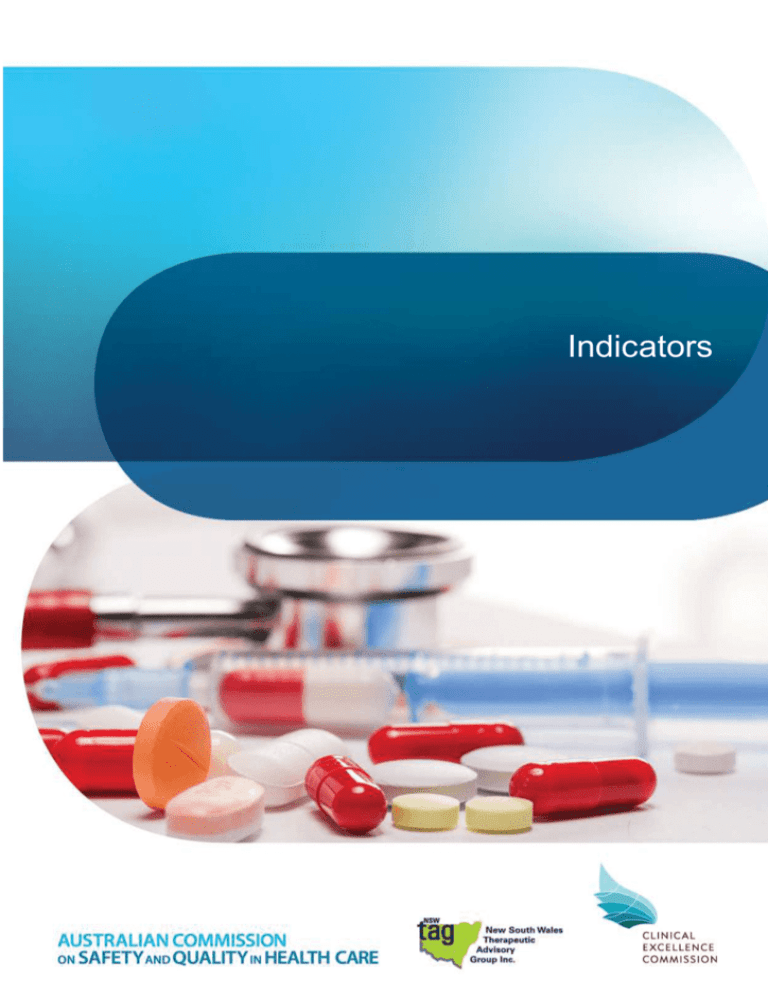
Indicators Antithrombotic therapy QUM domain: Judicious selection 1.1 Percentage of hospitalised adult patients that are assessed for risk of venous thromboembolism Purpose This indicator addresses the effectiveness of processes for preventing venous thromboembolism (VTE) in admitted patients. Background and evidence Deep vein thrombosis and pulmonary embolism (collectively known as VTE) are major, potentially fatal complications of hospital admission. The incidence of VTE varies with age, medical condition, co -morbidities, type of surgery and duration of immobilisation. 1 Both underuse and inappropriate use of VTE prophylaxis are recognised practice gaps in Australian hospitals2-4 and national initiatives have been developed to drive improvements in the use of VTE prophylaxis. 6,7 The Australian Commission on Safety and Quality in Health Care recommends that hospitals develop a policy outlining standard processes, procedures and responsibilities for assessing all adult patients for VTE risk and guiding the selection of appropriate prophylactic measures. 6 The policy should be approved by the local hospital drug and therapeutics committee, or other appropriate committee, and be informed by national recommendations such as those from the National Health and Medical Research Council. 7 Use of locally agreed processes for assessing and documenting VTE and bleeding risks in all adult patients, and locally agreed recommendat ions for the use of VTE prophylaxis may assist implementation of best practice. VTE risk assessment should be clearly documented in the medical record or, where applicable, on the inpatient medication chart, together with the appropriate prophylactic measures taken to minimise the risk of VTE. Ideally, the format and location for documentation should be standardised at a hospital level. Key definitions Hospitalised adult patients refers to all patients aged 18 years and over who have a length of stay in hospital greater than 24 hours from the time of their initial presentation. Assessed for risk of venous thromboembolism means that there is explicit documentation of a risk assessment and decision to use or to not use preventative measures by balancing the n umber and type of risk factors against risk of bleeding. This should be documented in the medical record, on the inpatient medication chart or in another designated place as determined by local policy. The assessment should be dated no later than the end o f the calendar day following hospitalisation. Data collection for local use Please refer to the section Using the National Quality Use of Medicines Indicators for Australian Hospitals for guidance on sample selection, sample size, measurement frequency and other considerations. Inclusion criteria: Patients aged 18 years and over admitted to hospital or the emergency department. Exclusion criteria: Patients with length of stay less than 24 hours from the time of initial presentation. Recommended data sources: Medical records and inpatient medication charts where applicable. National Quality Use of Medicines Indicators for Australian Hospitals 2014 2 The data collection tool for QUM Indicator 1.1 assists data collection and indicator calculation. Data collection for inter-hospital comparison This indicator may be suitable for inter-hospital comparison. In this case, definitions, sampling methods and guidelines for audit and reporting need to be agreed in advance in consultation with the coordinating agency. Indicator calculation Numerator = Number of adult patients that have a documented VTE risk assessment Denominator = Number of adult patients in sample Limitations and interpretation Performing a VTE risk assessment is essential to guide the judicious and appropriate use of VTE prophylaxis. See Indicator 1.2: Percentage of hospitalised adult patients that receive venous thromboembolism prophylaxis appropriate to their level of risk for further information regarding the use of VTE prophylaxis. It is recommended that Indicators 1.1 and 1.2 are collected concurrently where possible. It is recommended that data for different patient groups (e.g. medical, surgical, obstetrics) can be identified separately in order to inform post-audit interventions. Further information NSW TAG’s position statement on Safe Use of Heparins and Oral Anticoagulants for Venous Thromboembolism Prophylaxis in Adults may assist hospitals with development of policies and guidelines on the use of VTE prophylaxis.8 The National Health and Medical Research Council’s Stop the Clot program 5 assists organisations to integrate VTE prevention guidelines into routine hospital care www.nhmrc.gov.au/nics. A number of resources are also available from the Australian Commission on Safety and Quality in Health Care’s VTE Prevention R esource Centre 6 at www.safetyandquality.gov.au An e-learning module on prescribing VTE prophylaxis for clinicians is available from NPS MedicineWise at http://learn.nps.org.au Medication Safety Self Assessment for Antithrombotic Therapy in Australian Hospitals 9 (MSSA-AT) can help identify potential strategies for improvement with this and other indicators. MSSA -AT encourages development of robust systems for safe prescribing, dispensing, administration and monitoring of antithrombotic therapy. MSSA -AT is available at www.cec.health.nsw.gov.au This indicator can be used to assist hospitals in meeting the National Safety and Quality Health Service Standard 1 [items 1.2.1, 1.2.2, 1.5.2, 1.6.1, 1.6.2, 1.7.2, 1.8.1,] and Standard 4 [items 4.2.1, 4.2.2, 4.5.1, 4.5.2, 4.11.1]. 10 National Quality Use of Medicines Indicators for Australian Hospitals 2014 3 References 1. The Incidence and Risk Factors for Venous Thromboembolism in Hospitals in Western Australia 1999-2001 Prepared by The School of Population Health, University of Western Australia. Melbourne. National Institute of Clinical Studies, 2005. 2. National Institute of Clinical Studies. Evidence-Practice Report Volume 1:A Review of Developments:2004-2007. Canberra: National Health and Medical Research Council, 2008 3. Millar JA. Selection of medical patients for prophylaxis of venous thromboembolism based on analysis of the benefit-hazard ratio. Intern Med J 2009; 39: 606612. 4. Millar JA, Lett JE, Bagley LJ, et al. Eligibility for medical thromboprophylaxis based on risk-factor weights, and clinical thrombotic event rates. Med J Aust 2012; 196: 457-461. 5. Stop the Clot. Integrating VTE prevention guideline recommendations into routine hospital care, 3rd edn: National Health and Medical Research Council, 2011. 6. VTE Prevention Resource Centre. Australian Commission on Safety and Quality in Health Care. www.safetyandquality.gov.au/our-work/medication-safety/vte-prevention-resource-centre/ (Accessed 6 June 2014) 7. Clinical Practice Guideline for the Prevention of Venous Thromboembolism (Deep Vein Thrombosis and Pulmonary Embolism) in Patients Admitted to Australian Public Hospitals. National Health and Medical Research Council, 2009. 8. Safe Use of Heparins and Oral Anticoagulants for Venous Thromboembolism Prophylaxis in Adults. Position statement. NSW Therapeutic Advisory Group, 2010. 9. Medication Safety Self Assessment for Antithrombotic Therapy in Australian Hospitals. Institute for Safe Medication Practices USA (Adapted for Australian use by NSW Therapeutic Advisory Group and the Clinical Excellence Commission), 2007. 10. Australian Commission on Safety and Quality in Health Care. National Safety and Quality Health Service Standards. Sydney, ACSQHC, 2012. nd Quality in Health Care Level 5, 255 Elizabeth St, Sydney NSW 2001 GPO Box 5480, Sydney NSW 2001 Phone: (02) 9126 3600 (international +61 2 9126 3600) Fax: (02) 9126 3613 (international +61 2 9126 3613) Email: mail@safetyandquality.gov.au www.safetyandquality.gov.au NSW Therapeutic Advisory Group Inc 26 Leichhardt St, Darlinghurst NSW 2010 PO Box 766, Darlinghurst NSW 2010 Phone: (02) 8382 2852 (international +61 2 8382 2852) Fax: (02) 8382 3529 (international +61 2 8382 3529) Email: nswtag@stvincents.com.au www.nswtag.org.au National Quality Use of Medicines Indicators for Australian Hospitals 2014 4
